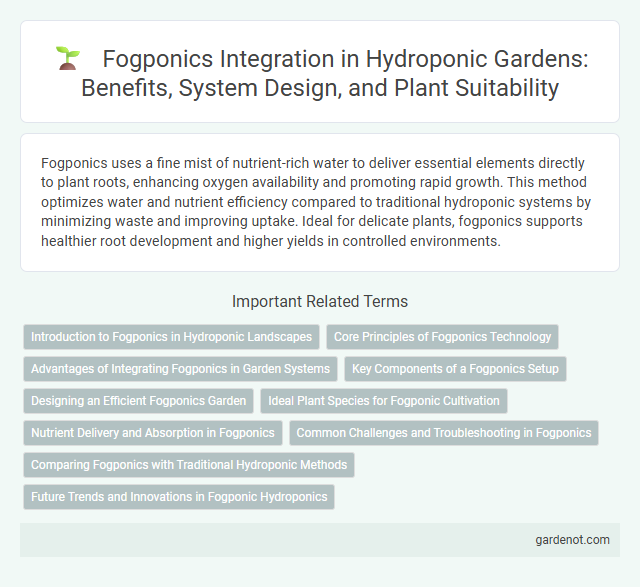Fogponics uses a fine mist of nutrient-rich water to deliver essential elements directly to plant roots, enhancing oxygen availability and promoting rapid growth. This method optimizes water and nutrient efficiency compared to traditional hydroponic systems by minimizing waste and improving uptake. Ideal for delicate plants, fogponics supports healthier root development and higher yields in controlled environments.
Introduction to Fogponics in Hydroponic Landscapes
Fogponics utilizes fine mist to deliver nutrient-rich water directly to plant roots, enhancing oxygen availability and nutrient absorption in hydroponic landscapes. This method increases growth rates and improves plant health by creating an optimal root environment with controlled humidity and nutrient density. Implementing fogponic systems in hydroponic gardens maximizes water efficiency and supports sustainable, high-yield agricultural practices.
Core Principles of Fogponics Technology
Fogponics technology utilizes ultrafine nutrient-laden mist to deliver water and essential minerals directly to plant roots, maximizing oxygen exposure and nutrient absorption. The core principles involve maintaining optimal droplet size, typically between 5 to 30 microns, ensuring efficient root respiration and preventing waterlogging. This method enhances growth rates and resource efficiency by creating a highly aerated root environment within the hydroponic system.
Advantages of Integrating Fogponics in Garden Systems
Fogponics uses ultra-fine nutrient-rich mist to deliver water and nutrients directly to plant roots, enhancing oxygen availability and boosting nutrient absorption efficiency. This method reduces water consumption by up to 90% compared to traditional soil gardening, making it highly sustainable. Integrating fogponics in garden systems promotes faster plant growth, improved yield quality, and minimizes root diseases due to superior aeration and precise nutrient delivery.
Key Components of a Fogponics Setup
A Fogponics setup primarily consists of ultrasonic foggers that produce nutrient-rich mist, an enclosed root chamber to contain the fog, and a nutrient reservoir to supply the misting solution. High-quality air pumps ensure adequate oxygenation, while timers regulate fog dispersion intervals, optimizing plant nutrient absorption and root hydration. Proper integration of these components enhances growth efficiency by increasing nutrient uptake and improving root aeration in hydroponic systems.
Designing an Efficient Fogponics Garden
Designing an efficient fogponics garden involves optimizing the mist particle size to enhance nutrient absorption and oxygen transfer to plant roots, typically targeting droplets between 5 to 30 microns. Utilizing high-quality ultrasonic foggers and ensuring proper reservoir aeration maximizes root zone humidity while preventing waterlogging, which boosts plant growth rates and nutrient uptake. Integrating sensors to monitor humidity, temperature, and nutrient concentration enables precise environmental control, fostering healthier, faster-growing hydroponic crops.
Ideal Plant Species for Fogponic Cultivation
Fogponics excels in cultivating delicate herbs like basil, mint, and cilantro due to its ultra-fine mist delivering optimal oxygen and nutrient absorption. Leafy greens such as lettuce and spinach also thrive in fogponic systems, as their root structures benefit from constant high humidity and aeration. Orchids and certain epiphytic plants adapt well to fogponics, mimicking their natural environments where roots absorb moisture from fog and air.
Nutrient Delivery and Absorption in Fogponics
Fogponics utilizes ultrafine nutrient mist to deliver essential minerals directly to plant roots, enhancing nutrient uptake efficiency compared to traditional hydroponic methods. This micronized nutrient delivery system increases root surface exposure, promoting faster absorption and improved plant growth. Optimized fog particle size ensures maximum nutrient bioavailability, reducing waste and enabling precise control over nutrient concentrations.
Common Challenges and Troubleshooting in Fogponics
Fogponics systems often face challenges such as nozzle clogging, inconsistent fog production, and nutrient solution imbalances that hinder optimal plant growth. Troubleshooting involves regular cleaning of ultrasonic foggers, ensuring proper pH and electrical conductivity levels in the nutrient reservoir, and maintaining stable temperature and humidity to prevent system malfunctions. Monitoring fog density and equipment performance helps mitigate issues and sustain efficient nutrient delivery in fogponic landscapes.
Comparing Fogponics with Traditional Hydroponic Methods
Fogponics uses nutrient-rich mist to deliver oxygen and nutrients directly to plant roots, resulting in faster growth and higher oxygen uptake compared to traditional hydroponic systems like nutrient film technique or deep water culture. This method reduces water and nutrient waste due to the fine particle size of the mist, enhancing nutrient absorption efficiency. Fogponics also supports healthier root systems by maintaining optimal moisture levels and enhancing aeration, which traditional hydroponics sometimes struggle to achieve consistently.
Future Trends and Innovations in Fogponic Hydroponics
Fogponics, an advanced hydroponic technique utilizing nutrient-rich mist to deliver oxygen and nutrients directly to plant roots, is poised for significant innovation through the integration of AI-driven environmental controls and IoT-enabled sensors, enhancing precision and resource efficiency. Emerging trends emphasize sustainable vertical farming applications and the development of novel nanoparticle-based nutrients to optimize growth rates and plant health in fogponic systems. These advancements promote higher yields, reduced water usage, and scalable solutions aimed at urban agriculture and space-limited environments.
Fogponics Infographic

 gardenot.com
gardenot.com